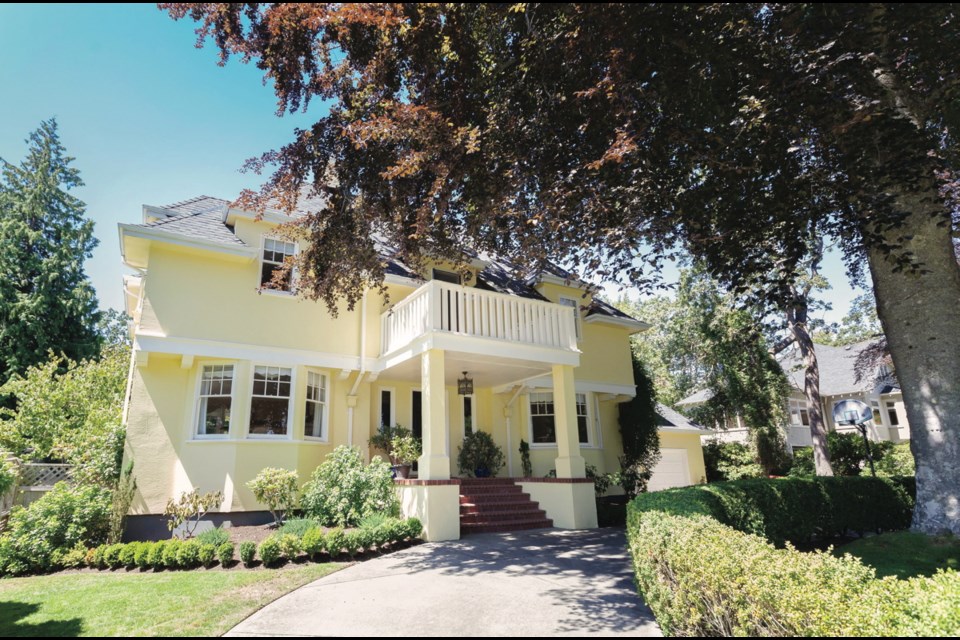The idea of Uplands homes being hidden behind gates with little life to them is put to rest within seconds of walking up to the Salomon house.
Ten-year-old Jenna zips around the circular driveway on her bike before racing off to somersault on the family’s trampoline. Through the open living-room window, you’ll hear the sounds of piano, violin, flute, drums or even electric guitar on any given day, as Bree, almost 12, practises one of the numerous instruments she plays.
Charlotte Salomon and her husband, Chris, bought the 1930s-built house in 2009, wanting a family home in which to raise their daughters.
“It’s a great fit for us, with the right amount of space and a garden that we all love,” says Charlotte, a lawyer with McConnan, Bion, O’Connor and Peterson.
The garden was on this year’s Victoria Conservatory of Music Mother’s Day tour, which highlighted how child-friendly the private property is.
It takes no coaxing for Jenna to give a detailed tour of the garden.
She points out the branch of an elm tree that is perfect for hanging piñatas at birthday parties, the pond she regularly mucks out (it had fish until a blue heron swooped in one morning), a moss-covered brick path that meanders behind the towering rhododendrons, and the butterfly garden — so called because that’s where the girls set butterflies free.
Jenna can also spiel off the colours of the 30-plus mature rhodos that are so large and healthy, the neighbouring homes can’t be seen.
The rhodos provide a spectacular show in the spring and early summer, until the numerous hydrangea and rose bushes take over. The family enjoys the organic fruit (no pesticides are used in the garden) from apple and plum trees and had a bounty of about 100 kiwis from their vines last fall.
As well, Jenna has a vegetable and herb garden, with zucchini plants from her grandmother and others she bought with money earned selling lemonade. She started growing veggies in a Grade 3 class and has a growing green thumb. And she loves that her vegetables are cooked up for family dinners.
The sense of family-friendliness extends throughout the 4,000-square-foot house. The airy and bright house has large rooms that mix the traditional with touches of art deco flair, such as the dark oak bannister with its generous curves, and coved ceilings throughout.
A 1990s renovation by previous owners yielded a large modern kitchen that adjoins a family room and family dining area overlooking the garden, as well as updated bathrooms. The previous owners kept the rest of the house true to its era, replacing doorknobs throughout with glass ones and retaining the original plaster walls in most of the rooms.
The formal living room is high-ceilinged and filled with light, with views to the garden. Its décor reflects the family life lived here.
“This is our living room, music room, art room, Lego room and doll room,” says Charlotte with a laugh.
An Edwardian marble-topped French commode is topped with a Lego creation and the girls’ cacti collection. An 18th-century walnut armoire holds American Girl accoutrement. The Chobi carpets are usually dotted with more Lego, a set of bongo drums and whatever art project Bree is working on.
An Edwardian painted walnut piano from Harrods is great to play and to use as a Barbie prop.
Antiques fill the home, no surprise given that Chris is a retired antiques dealer. Antiques are meant to be lived with and used, not hidden away or kept off-limits, he says.
“We both love antiques and we don’t fuss about them. They’re meant to be used. Use them, have the kids play with them. They might get scratched or they might get broken, but life goes on,” he says.
The couple can mark life events with the antiques in the home. A two-foot-tall wooden cherub in the foyer was Jenna’s goal when she was learning to walk.
“She wanted to kiss the cherub,” says Charlotte.
Two large Japanese imari porcelain vases by the fireplace survived both girls as active toddlers without a chip.
An 1870 credenza made entirely of satinwood with a signature blue Wedgewood plaque is one of the girls’ faves. They like the fuzzy pompom on the key.
“We like that antiques can be a bit imperfect,” Charlotte says, pointing to several needlework samplers done by children in the 1800s, still in original but chipped frames.
“They’re not perfect but nothing is. The imperfections make the pieces more interesting. And they fit the nature of the house. These plaster walls are meant for imperfection.”
And the family likes the stories antiques tell.
Another military chest is a recent addition, dating to 1870. The chests with their drawers and built-in desks were made for military officers and are, Chris says, “virtually indestructible” — and very usable antiques to have in a home. The family has several throughout the house, including the most recent one with a burn mark on the top.
“More than 100 years ago, a candle must have tipped over. Who knows what happened? You never know the history and the stories that come with these pieces of furniture, but it really piques the imagination,” Charlotte says.
It’s not hard to imagine some point in the future when others might enjoy the antiques from the Salomon home, wondering where that little piece of pink Lego jammed in a back corner came from, and who played with it, or what creation that speck of paint was part of.
Furniture and how it is used, like a home, tells the story of a family and its life.



